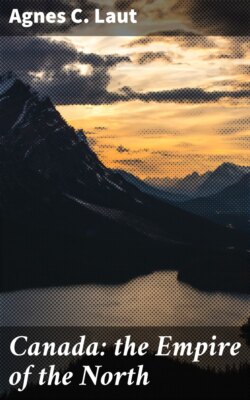Читать книгу Canada: the Empire of the North - Agnes C. Laut - Страница 31
На сайте Литреса книга снята с продажи.
SAMUEL DE CHAMPLAIN
ОглавлениеBefore the boats sight Acadia, it is early summer of 1604. Pontgravé leaves stores with De Monts and sails on up to Tadoussac. De Monts enters the little bay of St. Mary's, off the northwest corner of Nova Scotia, and sends his people ashore to explore.
Signs of minerals they seek, rushing pellmell through the woods, gleeful as boys out of school. The forest is pathless and dense with June undergrowth, shutting out the sun and all sign of direction. The company scatters. Priest Aubry, more used to the cobble pavement of Paris than to the tangle of ferns, grows fatigued and drinks at a fresh-water rill. Going in the direction of his comrades' voices, he suddenly realizes that he has left his sword at the spring. The priest hurries back for the sword, loses his companions' voices, and when he would return, finds that he is hopelessly lost. The last shafts of sunlight disappear. The chill of night settles on the darkening woods. The priest shouts till he is hoarse and fires off his pistol; but the woods muffle all sound but the scream of the wild cat or the uncanny hoot of the screech owl. Aubry wanders desperately on and on in the dark, his cassock torn to tatters by the brushwood, his way blocked by the undisturbed windfall of countless ages, … on and on, … till gray dawn steals through the forest and midday wears to a second night.
Back at the boat were wild alarm and wilder suspicions. Could the Huguenots, with whom Aubry had battled so violently, have murdered him? De Monts scouted the notion as unworthy, but the suspicion clung in spite of fiercest denials. All night cannon were fired from the vessel and bonfires kept blazing on shore; but two or three days passed, and the priest did not come.
De Monts then sails on up the Bay of Fundy, which he calls French Bay, and by the merest chance sheers through an opening eight hundred feet wide to the right and finds himself in the beautiful lakelike Basin of Annapolis, broad chough to harbor all the French navy, with a shore line of wooded meadows like home-land parks. Poutrincourt is so delighted, he at once asks for an estate here and names the domain Port Royal.
On up Fundy Bay sails De Monts, Samuel Champlain ever leaning over decks, making those maps and drawings which have come down from that early voyage. The tides carry to a broad river on the north side. It is St. John's Day. They call the river St. John, and wander ashore, looking vainly for more minerals. Westward is another river, known to-day as the Ste. Croix, the boundary between Maine and New Brunswick. Dochet Island at its mouth seems to offer what to a soldier is an ideal site. A fort here could command either Fundy Bay or the upland country, which Indians say leads back to the St. Lawrence. Thinking more of fort than farms, De Monts plants his colony on Ste. Croix River, on an island composed mainly of sand and rock.
While workmen labor to erect a fort on the north side, the pilot is sent back to Nova Scotia to prospect for minerals. As the vessel coasts near St. Mary's Bay, a black object is seen moving weakly along the shore. Sailors and pilot gaze in amazement. A hat on the end of a pole is waved weakly from the beach. The men can scarcely believe their senses. It must be the priest, though sixteen days have passed since he disappeared. For two weeks Aubry had wandered, living on berries and roots, before he found his way back to the sea.
